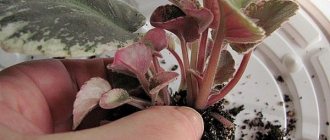A healthy, properly developing Saintpaulia forms a compact, rounded rosette of velvety leaves. But the main decorative value of the plant is its flowers. A bush looks especially beautiful if many buds open on it at the same time, forming a lush halo or a dense bouquet over the foliage, rather than single corollas. But sometimes the violet does not bloom. This happens for various reasons, but almost always due to incorrect actions or oversight of the owners.
Violet brings exceptional benefits
Violet is associated with something fabulous and magical:
- Brings harmony to the family.
- Relieves negative thoughts.
- The smell relaxes the body and pleases the soul.
- For lonely people it can improve their personal life.
- It has a beneficial effect on children and calms their emotional state.
- Helps improve mood.
- Treats bronchitis.
- Used for vascular diseases.
- The leaves can reduce the temperature.
- Relieves headaches.
Interesting fact: thanks to this flower, the romance between Napoleon Bonaparte and his lover began.
Violet is an unpretentious plant, but needs proper care. If you care for it incorrectly, the flower may die. There is a sign that violets bloom only in close-knit families.
Container for violets
A properly selected pot greatly influences the flowering of violets. I grow violet babies in 100 ml cups, and when they grow up, I transplant them into pots with a diameter of no more than 6-8 cm: in large pots, violets can grow a large rosette, but will not bloom early. In addition, it is more difficult to fill a violet growing in a small pot.
- Photo by Irezine Herbst
These are the subtleties you need to comprehend so that violets bloom on your windowsills almost all year round. I hope you find my advice useful, and I wish you all health and every success.
Correct flower transplant
Once you bring the violet into the house, do not rush to place it with other plants. She loves solitude.
How to properly and carefully replant Saintpaulia? You need to take a pot a little larger than at the moment. Violets need to be replanted twice a year. Now we’ll tell you how to do this correctly:
- A day before transplanting, water the violet well with warm water.
- After this, we pull out the plant along with the soil and then plant it in a new pot.
- We free the roots from the ground and process them if necessary.
- We place the plant in a new pot and fill it with fresh soil up to the lower leaves.
- To fill the voids inside, shake the container lightly.
- The plant should be in a dark place for one day. This is how the violet gets used to the new place and all the wounds heal faster.
Air humidity is a necessary condition for flowering
Both high temperature and excessive dry air are a significant reason why violets do not bloom. For comfortable development and flowering, Saintpaulias need an air humidity of about 50%.
In an apartment, especially from autumn to spring, when heating devices are on, the air is sometimes much drier, which slows down the growth of the rosette and the set of buds. Especially young rosettes and “aged” plants, which in the near future need rejuvenation and replanting, suffer from this lack of care for indoor violets, which is why they bloom poorly.
You can provide plants with comfortable conditions for the formation of flower stalks by using household humidifiers, as well as placing trays of water on racks with flowers. In special cases, when the appearance of the plant suffers, the rosette, without affecting the flowers, is sprayed with warm water. If necessary, the procedure is repeated after two or three days.
Creating a comfortable environment for violets
The plant needs long-term lighting of at least 10-12 hours. Bright sunlight is dangerous for violets; the leaves get burned and can become sick. The best location for a flower is on shelves where there is no bright sun . The temperature in the room should not exceed 24 degrees.
High humidity is required, approximately 55-63%. In winter, it is better to remove the pot from the windowsill, especially if there is a heating system nearby. The air around the flower must be sprayed, but not on the plant itself. The flower is placed in a tray with wet expanded clay. With low humidity, the buds develop slowly.
The plant is very demanding when it comes to watering. Violets like fairly infrequent watering - about once every 6-9 days. The water must be clean, settled, and must correspond to a certain temperature. Filtered water is also suitable for irrigation. It is not advisable to spray the leaves to avoid the risk of fungal infections.
Varieties of violets with photos and names
Blue Dragon
The leaves are hairy and have a serrated edge. The lower tier of leaves is red. The rosette can reach a diameter of 50 cm. It has large double flowers of a dark blue color.
Harry Potter
The leaves are drooping, pale green. The rosette is dense and small. Large soft blue flowers edged with white.
Cupid
The leaves are green and shiny. The rosette is large and wavy. Blooms profusely, double inflorescences are white with a green border.
Breath of the Storm
It has dark green leaves with a wavy edge on a long stalk. Small socket. Large purple flowers with white edges.
Macho
The leaves are ovate, green. The flowers are double, purple-burgundy with a white border.
Jan-whim
The leaves are wavy and pinnate. The inflorescences are white with a green corrugated border.
Water
Wavy leaves of a light green hue. It has dark blue double buds with a green edge. Seawolf The foliage is dark green. Double flowers are blue and very large.
Parisian secrets
The leaves are spotted, white-green. The double lilac flowers have a greenish-white border.
Jabot
The leaves are deep green with a wavy edge. Terry lilac flowers along the edge turn into a green tint.
Flowering period
It is impossible to pass by and not pay attention to the beautiful cap of violet flowers; it involuntarily attracts the eye.
What needs to be done to achieve abundant flowering? One leaf contains one flower, we need to remove the top row of peduncles, so we get new ones.
When growing the second row of flowering shoots, we repeat the plucking procedure. And we leave the third tier if the number of flower shoots that appear is satisfactory. If you want more, then remove the third row completely.
After removing the flower buds, the violet changes in growth. To achieve good flowering, you need to form a rosette and process:
- lateral shoots on the stem;
- leaves that are in the first row;
- and those that interfere with the symmetrical development of the rosette.
When the plant grows and gains the required volume, we leave the buds that have appeared. After 5 months, the flower reaches a beautiful blooming cap.
Remember that the plant can bloom only in a well-groomed outlet. To do this, you need to comply with all the conditions at the initial stage of development.
How to feed violets to make them bloom?
When asking what to do if violets do not bloom, lovers of indoor plants often force the plant to behave in this way. It's all about illiterate or excessive feeding, which causes serious damage to the health of the rosette and its ability to produce flowers.
The most common mistake is an excess of nitrogen in the soil, which causes the violet not to bloom, but to produce more and more new leaves and form stepchildren, which, as they develop, take away strength from the parent rosette. Doomed to excess nitrogen consumption, the violet plant is less resistant to diseases spread by fungi.
You can make a violet bloom only with very moderate and competent use of fertilizers. Plants that have just experienced a long and abundant flowering experience the greatest need for feeding. In this case, complex formulations are used for flowering crops, and the content of phosphorus and potassium in them should be twice as high as nitrogen.
You can hear the question from flower growers: “How to feed violets so that they bloom after transplanting?” But in this case, it is better not to rush into applying fertilizers at all, since plants that require acclimatization will not be able to correctly absorb the minerals that have entered the soil, and besides, fresh soil necessarily includes everything necessary for growth.
By slightly increasing the acidity of the soil at the stage when violets are laying buds, you can achieve brighter flowering in varieties whose petals combine contrasting shades, have a fringed border and scattering splashes of color.
How to increase violet reproduction from leaves
Propagating this wonderful flower is not difficult at all. You can ask for a leaf for brood or cut it from an existing flower. Favorable time is from February to May. Any healthy leaf from the top or middle rows is suitable for brood. The sheet must be undamaged.
Propagation of the shoot in a container of water
- We make an oblique cut at the cut leaf, the stem is pointed at the end.
- Then rinse under water and dry. Activated carbon can be used to process the cut.
- Next, take a convenient container: fill a small jar, shot glass or other container with water.
- We settle or filter the water.
- We immerse the stem in water about 1 cm and wait; after four weeks or even less, the first roots appear.
- The water must be changed once a week.
Substrate propagation of violet leaf
- We prepare the cuttings as in the first method.
- You can take a plastic glass, then cut out a small hole for drainage.
- The substrate must be moist.
- The cutting should be planted a little more than one cm.
- A glass with a branch is placed on the tray.
- Then pour water into the pan.
- The shoot should not dry out; to do this, add water in a timely manner.
- We create a small greenhouse, cover it with polyethylene and make small holes for air to pass through.
- We are waiting for the appearance of small leaves and transplanting the violets into the ground.
Violet – loves caring attitude. If the plant feels good in the created conditions, it will show itself in all its glory.
Selection of soil for lush flowering of violets
The reason why the violet does not bloom may be untimely replanting of the plant or incorrect selection of the soil mixture. Typically, Saintpaulia rosettes are transferred to another soil after approximately two flowerings, that is, twice every 1–1.5 years. If this is not done, the plant does not have enough nutrition, it weakens and eventually refuses to bloom.
But what to do in a situation where the florist makes every effort to care for the violet so that it blooms, but there are practically no buds? The error may lie in incorrectly selected soil. Violets react extremely poorly to dense soil that accumulates a lot of moisture. In such a mixture, the plant has difficulty forming a root system, and existing roots rot.
To ensure that the soil retains its lightness and looseness, but does not lose its ability to retain moisture, vermiculite and perlite are added to it, and natural antiseptics are used - sphagnum moss and powdered charcoal.
Sphagnum in the form of a crushed mass is added to the soil, and whole stems of the plant, along with expanded clay and foam chips, are used as drainage, which is mandatory for violets.
When planting violets in ready-made or self-selected soil, be sure to check its acidity. For Saintpaulias, soil with a slightly acidic reaction is most suitable. The acceptable level can vary from 5.5 to 6.5 units. By taking advantage of all the recommendations for caring for indoor violets, the gardener is sure to get luxurious blooms of his favorite Saintpaulias.
How to protect violets from diseases
It is not difficult to care for the plant at home, but if you neglect the rules, problems may arise and, accordingly, the flower will die. The irrigation regime must be observed; lighting and soil composition play an important role.
Let's look at the most important things that need to be observed. to fertilize the violet with fertilizing once every two weeks. Autumn is the time when the use of all vitamins should be reduced. Feeding is carried out in winter. It is better to purchase fertilizers with phosphorus.
After flowering, the violet is processed, dried leaves are removed, single buds are removed with scissors, or a bamboo stick with a blunt end is used so as not to damage the stem of the bush.
Nuances of violet (Saintpaulia) care
This is a slightly whimsical plant, but by following simple rules of care, you can achieve abundant and beautiful flowering from it. Let's talk about how to care for violets.
How long does a violet bloom?
Up to 10 months. With variable abundance. It is important to give the plant a rest for at least a couple of months, for which purpose during the flowering period we tear off the faded buds and flower stalks. More details later in the article.
Temperature
It should be uniform all year round: +20º - +22º. When it is hot, above +28º, turn on the air conditioner or fan, but make sure that the air currents are not directed towards the violet.
You can also place Saintpaulia on the floor during this period: this can help avoid overheating. Frozen water bottles will also lower the room temperature.
Spraying
There is no need to do this: water that gets into the middle of the rosette can cause the flower to rot. However, Saintpaulia does not like and reacts poorly to dry air, so it is advisable NOT to place it near a battery.
Important: moisten the air from a spray bottle around the violet, trying not to get on it. And then let it dry. Don't rush to return her to the window or under the lamp. Wet leaves + ultraviolet light = burns.
Also, to increase the humidity in the room, place a saucer of water next to the violet, which, as it evaporates, will create the microclimate it needs, or buy an air humidifier and place it near the plant.
Lighting
Saintpaulia (violet) should not be placed on a south, south-east or south-west window: this will expose it to direct sunlight all day. If there is nowhere else to place the flower, then hang curtains or blinds. You can also cover the window with translucent film. These methods will help to artificially create partial shade in the room.
The violet needs light, so in the evenings, especially in winter, it can be placed under a lamp, providing 14 hours of daylight.
Watering violets (Saintpaulia)
You should avoid getting moisture on the leaves when watering so that the flower does not rot. It is also important not to overdry the soil, but at the same time not to allow water to stagnate in the pot. The soil should always be consistently slightly moist. Improper watering affects the quality and quantity of inflorescences.
Before watering, test the soil with your finger. If the ground is wet, try again in two days.
For irrigation, choose water that has been standing for at least a day at room temperature. You can use boiled or filtered water. Cold water can cause violet roots to rot.
Watering through a tray
This way, water will not get on the foliage, but the flower may not have enough moisture. Therefore, 15-20 minutes after watering, check whether the top layer of soil is well moistened. Excess water from the pan must be drained.
Drip irrigation
To do this, we use a syringe bulb or a watering can with a narrow spout and water the plant along the edge of the pot, slowly turning it around its axis.
Immersion method
The water in the basin needs to sit for about a day. Then we place the flowerpot with Saintpaulia there and leave it there for an hour. This method works best during periods of extreme heat. It will allow the flower to rest and receive the necessary moisture. Before returning the Saintpaulia to its place, make sure that excess water has drained through the drainage holes.
Watering with a wick
Take a strip of fabric that is highly permeable to moisture. It is advisable to choose synthetic rather than cotton material for this, so that it does not rot or decompose.
The strip is threaded through the drainage hole and passed through the entire pot. The tail of the fabric should remain in the tray. Next, the pot is covered with earth. We pour water into the pan, and the wet wick provides moisture to the entire plant.
To increase the acidity of the water, once a month the water can be watered with acidified acetic (1 tsp per 1 l) or citric (5 crystals per 1 l) acid.
Selecting the substrate
Prefers slightly acidic soil with a pH value of 5.5-6. In an environment that is too acidic or too alkaline, the violet will grow slowly, unopened buds will fall off, and this will also affect the beauty of the foliage. It is difficult to choose suitable soil on your own, so it is better to give preference to ready-made store-bought mixtures.
When preparing the soil yourself, mix the soil with crushed sphagnum and perlite in a 1:1:1 ratio. The substrate will be slightly sour and breathable.
Checking acidity
There is a special device for this. But you can do without it. To do this you need to take two lumps of earth. Add vinegar to the first one: in an alkaline environment it will hiss. Sprinkle another lump with soda: if bubbles appear, the medium is acidic. Otherwise the soil is neutral.
Life hack: dolomite flour reduces acidity, and peat increases it.
Feeding and fertilizer
It reacts favorably to any fertilizing; it is advisable to fertilize it during the entire flowering period of the violet. Even in winter, if it gives color. Alternate fertilizing for flowering plants with fertilizers for decorative foliage plants. Do not increase the dosage indicated on the label to avoid mistakes.
The plant accepts fertilizers containing vitamins B1, B6 and B12 well. Buy Neurobion at the pharmacy and dilute 1 ampoule in 1 liter of water. You can fertilize in two ways: spray the air around the violet so that nutrients settle on the foliage, or feed the soil.
Special fertilizers for violets are also suitable, for example, Agricola (diluted according to instructions).
We fertilize once every two weeks while Saintpaulia is actively growing and giving color. If the temperature rises above +28º, it is better to refrain from feeding, as the plant experiences stress and may react inadequately to feeding, which will affect the leaves and flowers.
After transplanting the plant, you can start fertilizing it in two to six months.
Important: you can fertilize the soil only when it is wet.
Transfer
The plant may begin to bloom worse if one pot is occupied by several rosettes. Plant them in different pots. If the diameter of the rosette has become three times larger than the diameter of the pot, it is also time to look for a new pot.
Important: at temperatures above +28º it is better not to replant the plant: it is already under stress.
Transshipment method
Suitable for young Saintpaulias.
- We take the plant out of the pot along with the substrate.
- We tear off the bottom layer of leaves.
- Choose a pot of larger diameter with drainage holes.
- We plant the violet in a new pot, adding fresh soil.
- We water the transplanted Saintpaulia no sooner than every other day.
Important: if the violet has bloomed, you need to either let it bloom, or remove the inflorescence and only then replant it.
Replanting with soil replacement
Suitable for an adult plant that does not need to change the pot: it is enough to completely or partially replace the soil with fresh soil.
- Remove the violet from the pot.
- We wash and disinfect the pot with any detergent without aggressive surfactants (SLS, SLES), and then rinse it thoroughly.
- Place fresh soil in the center.
- We clean the roots from the substrate and inspect for damage.
- We remove the rotten roots and sprinkle these places with activated carbon, crushed into powder, after which we immerse it in a solution of Fitosporin for 3-4 hours (½ tsp per 100 ml of water).
- Cover the plant with soil.
- It is advisable not to expose the plant to the sun or water it during the day.
It is best to replant violets in the spring, when they do not bloom and do not grow green mass of leaves.
Hygiene of violets
Saintpaulia leaves need to be kept clean. You can brush away dust with a clean brush, for example, an unnecessary blush brush. You should not use sponges or brushes to avoid damaging the plant.
You can also rinse the leaves in warm water. The main thing is to make sure that it does not fall into the center of the rosette, and after the procedure, dry the leaves well before returning it to the windowsill. Otherwise, sunburn may occur.
Rejuvenation
Saintpaulia needs to be rejuvenated four years after planting. To do this, the top is removed, leaving a stalk 2 cm long. After some time, children appear on it, which can later be planted to propagate the flower. The broken off tip can also be rooted to form a new plant.
Trimming
To improve appearance, rejuvenate, stimulate flowering, or if diseased leaves appear, Saintpaulia is pruned. Violet leaves usually grow in three rows.
Removing leaves to stimulate flowering
If the plant begins to produce a lot of succulent leaves, you need to remove the bottom row of leaves so that Saintpaulia does not spend all its energy feeding them. This procedure will help improve the quality of flowering.
Rest period
It occurs in violets after flowering has ended. When it ends, trim off the old dry leaves, those that have turned yellow and withered.
The bottom row can be completely removed, and Saintpaulia can also be replanted. If you do not plan to replant the flower, you can start fertilizing it so that it grows fresh leaves. It is also recommended to reduce watering during the dormant period.
Is it necessary to remove fading violet flowers?
Yes, they can be removed. Just carefully pinch them off or remove them with scissors. If there are still unblown or flowering buds on the peduncle, then it does not matter how long the remaining cuttings are.
Thanks to this manipulation, the plant will look presentable, plus it will not have to waste energy maintaining faded flowers.
How to remove a faded peduncle from a violet
If all the buds on the peduncle have faded, you can completely remove it. It is better to break off the peduncle to the very root, as far as the leaves allow.
Ideally, you need to remove it so that there is no stump left. It's more aesthetically pleasing. Plus, the remaining stump may rot and fungus will appear on it.
But you don’t have to remove the peduncle. Nothing bad will happen.
If you don't touch it, it will calmly finish its life cycle and dry up. You can delete it at any time convenient for you.
If your violet has enough moisture, sun and nutrition, it will calmly continue to bloom.
Care during the cold season
Maintain a stable temperature, do not place on cold, drafty window sills or near radiators, avoid drafts. Make sure that the temperature is not lower than +18º.
Place the pot on a stand, otherwise the roots may freeze. Water with warm water and less often than in summer - do not overwater Saintpaulia.
Ideally, in the evenings, place the violet under a phytolamp. But this is desirable, not mandatory.











